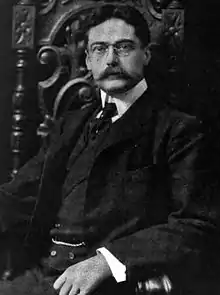Richard Howland Hunt
Richard Howland Hunt (14 March 1862[2] — 12 July 1931) was an American architect and member of the notable Hunt family of Vermont, who worked in partnership with his brother Joseph Howland Hunt (1870 — 11 October 1924) in New York City, as Hunt & Hunt. The brothers were sons of the first American Beaux-Arts architect, Richard Morris Hunt (1827–1895). Richard practiced in his father's office until the elder Hunt's death in July 1895, and continued, not without initial resistance on the part of trustees,[3] to carry out his father's designs for the central block of the Metropolitan Museum of Art.[4] After a brief interval, the brothers formed a partnership in 1901[5] that was only terminated by Joseph's death in 1924.
Richard Howland Hunt | |
|---|---|
 | |
| Born | March 14, 1862 |
| Died | July 12, 1931 (aged 69) |
| Resting place | Newport, Rhode Island[1] |
| Alma mater | Massachusetts Institute of Technology École des Beaux-Arts |



Richard Howland Hunt, the older son, studied architecture at the Massachusetts Institute of Technology and the École des Beaux-Arts, Paris, where his father Richard Morris Hunt had studied. In 1887 Richard Howland Hunt joined his father's offices, first as a draftsman and later an associate. In the interim following his father's death he attracted wealthy clients and built residences such as the Margaret Shepard house at 5 East 66th Street (1900), now housing the Lotos Club.[6]
Joseph Howland Hunt studied at Harvard College and the School of Architecture at Columbia University before following his brother to the École des Beaux-Arts, returning to New York in 1901. Urban residences by Hunt & Hunt include the two Beaux-Arts houses designed for George W. Vanderbilt at 645 and 647 Fifth Avenue, known as The "Marble Twins". Only No. 647, a designated New York City Landmark, survives today.
The brothers were primarily known for their elegant residences in Long Island, Tuxedo Park, New York, and Newport, Rhode Island. Their armory building for the 69th Regiment, New York, was the first armory to abandon pseudo-medieval crenellations.
Selected commissions
- George Washington Vanderbilt Houses, 645 and 647 Fifth Avenue, New York, called the "Marble Twins". 1902-05. Number 647 survives, a designated landmark, as the flagship store for Versace;[7] the site of 645 is now Olympic Tower.
- Forest Hall, Milford, Pennsylvania. 1903. For James Pinchot, for whom Richard Morris hunt had built Grey Towers. (National Register of Historic Places)
- Sanderson estate, Oyster Bay, Long Island.[8] (1885).[9]
- 69th Regiment Armory, between 25th and 26th Streets and Lexington and Park Avenues. 1903-06.[10]
- Saddle Rock House, Shippan Point, Stamford CT 1914, for inventor Thomas Robins. [11]
- Terre Bonne, Shippan Point, Stamford, CT 1914, for pioneer film maker/movie producer Frank J. Marion. </ref> New York Times, October 2, 2005, Real Estate section, "A Neighborhood to Move Around In", by Lisa Prevost.
- Edward Harden Mansion, Sleepy Hollow, New York, 1909.
- Sabine Farm Greenwich, Connecticut, 1910, for publisher H. J. Fisher [12]
- First Precinct Police Station, New York. 1909-11.
- Amos R. E. Pinchot House,[13] Park Avenue at 85th Street. 1910.[14]
- Beacon Towers, Sands Point, Long Island, 1917–18, for Alva Belmont. It was their last commission on the Gold Coast.[15]
- Alumnae House and Williams House, Vassar College. 1924. Half-timbered construction.[16]
Collaborations with sculptors
As did many of the architects of the time, Hunt & Hunt designed bases and pedestals for sculptors. These include:[17]
- William McKinley Monument by Charles Mulligan, Chicago, Illinois, 1905
- Sighting the Enemy for Edward Clark Potter in Monroe, Michigan, 1910
- Lafayette Monument by John Ferguson Weir, Milford, Pennsylvania
References
Notes
- "Richard Howland Hunt, New York City Deaths". familysearch.org.
- Richard was born in Paris, where his father was completing his architectural studies.
- Baker, Paul R. Richard Morris Hunt Cambridge, Massachusetts:MIT Press 1980:442ff.
- Hunt was unable to persuade the Museum's trustees to complete the sculptural groups. Bogart, Michele H. Public Sculpture and the Civic Ideal in New York City 1989:158-65
- Landmarks Preservation Commission: First Precinct Police station, 20 September 1977 Accessed 2 December 2008. Basic biographical details.
- White, Norval & Willensky, Elliot (2000). AIA Guide to New York City (4th ed.). New York: Three Rivers Press. ISBN 978-0-8129-3107-5.
- Gray, Christopher. "Streetscapes: 647 Fifth Avenue; A Versace Restoration for a Vanderbilt Town House" The New York Times (April 9, 1995) accessed 2 December 2008.
- Library of Congress.
- Milford Heritage Tour.
- The armory.
- The Architectural Record November 1916, Three Connecticut Country Houses, Vol XL No 5
- Pinchot was the brother of the conservationist Gifford Pinchot, superintendent of the forest surrounding Biltmore, built by Richard Morris hunt for George Washington Vanderbilt, completed by Richard H. hunt in 1896.
- Trager, James. Park Avenue, Street of Dreams (Atheneum, 1990).
- MacKay, Robert B.; Anthony K. Baker; Carol A. Traynor (1997). Long Island Country Houses and Their Architects, 1860-1940. New York: Society for the Preservation of Long Island Antiquities in association with W.W. Norton & Co. pp. 231–232. ISBN 978-0-393-03856-9.
- historic CVampus Architecture Project: Alumnae House.
- Search results: "Hunt & Hunt, architectural firm" on the Art Iventories Catalog of the Smithsonian American Art Museum via the Smithsonian Institution Research Information System
Bibliography
- Mackay, Robert; Baker, Anthony; and Traynor, Carol eds. Long Island Country Houses And Their Architects 1860 to 1940
External links
 Media related to Richard Howland Hunt at Wikimedia Commons
Media related to Richard Howland Hunt at Wikimedia Commons